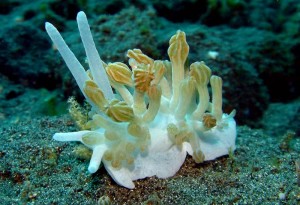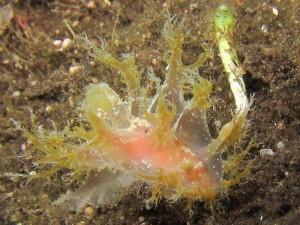
For nudibranch/opisthobranch lovers who enjoy diving and photography, going on expeditions or dive charters with specialised guides who have their own sites for these fantastic creatures!
What is a nudibranch?
A nudibranch is basically a sea slug, though nothing like your common bland looking garden slug. These come in a huge range of colour forms & body shapes. There are species that mimic corals, certain species mimic poisonous marine animals while others actually eat but only ingest poisonous corals to fend off the likes of yes, cannibalistic nudibranchs and check this out; there are even species that can photosynthesize the suns rays just like plants do. If this piques your interest, read on for more about these fascinating animals, who and why divers go in search of them…
Who?
I’ve heard of people interested in these weird and wonderful critters calling themselves Branchers, Nudiphiles, Sluggers and even nudi nutters. Call them what you like, it’s really addictive and finding new species no other people have ever seen, really is cool! It also happens to be very interesting too.
I have seen divers get into diving and eventually think they know it all as they have seen endless schools of fish, sharks, rays and endless pristine coral reefs though when a divers starts to discover the joys of critters and even nudibranchs a whole new world opens up to them.
So why do we chose to look for nudibranchs?
Apart from them these gorgeous animals being the most colourfully diverse animals on the planet they also happen to be perfect photographic subjects. Most of the species do not travel at high speed to avoid cameras, do not get blinded by strobes and are generally found in a huge variety of habitats. Plus, when looking for nudibranchs we always manage to find just about all the other wish list critters a diver could ever ask for. We also find a lot of unknown species aside from nudibranchs.
My bizarre history with nudibranchs
I first took an interest in nudibranchs while diving on Sipadan. I suppose my entry into the macro life was a little stranger than most divers as I only had about 20 dives under my belt at the time. This was back in 1997, it was also my first proper dive resort holiday. After numerous dives on the same sites I kind of wanted to see more than just sharks, barracuda, jacks and turtles. Being one for knowledge I really just wanted know what else was down there. With my Canadian dive buddy who was also into the unknown, we went in search of the things the guides passed up on all the time. My interest in nudibranchs and all other cool marine animals was always strong as I kept finding lots of animals that I couldn’t identify in the books available at the time.

Then in 1999 after becoming an dive instructor in Australia I was backpacking my way to try and see if I could get work by landing right on the doorstep of Wakatobi Dive Resort. The place and the name just sounded so cool and far from everywhere else, right off the beaten track and this is what I was after. It took me quite a few days from Bali via Makasar, then by local boats. Once I had arrived at the harbor in Bau Bau who’s literal translation means smell smell, still makes me giggle when I hear it. Anyway, I asked how to get to Wakatobi and the locals kept saying a name of an island I thought wasn’t quite right but I went along with local knowledge anyway. I was still young and fresh in Indonesia with very little knowledge of the local language under my belt, though I was learning very fast! It took me a few dodgy ferry rides from one island to another and then finally I arrived. The adventure was well worth it as I was on a gorgeous scenic white sand beach fringed with what looked like a deep drop off. My first question was “where is Wakatobi Dive Resort”, the reply came over a little alarming “oh, about 3 islands south of here”. Yes, I was on the wrong island though all wasn’t lost, I suppose it was fate, or something that drew me here as the lady who greeted me was Geertje Berveling who now runs www.tukangbesidiving.com which is a great budget way to dive another area of the Wakatobi island group. Geeertje told me the island I was on was called Pulau Hoga which happened to have a survey station based on it called Operation Wallacea. I had heard of this before so I was kind of pleased with my mishap. Geertje very kindly took me over where my first introduction was to Lindsay Warren who told me that she was in charge of a none other than opisthobranch survey. I think my keen interest in nudibranchs came across as I ended up as a volunteer, additional survey instructor and guide within a few minutes of chatting to Lindsay and team leader Dan Johnson. We recorded hundreds of species of nudibranchs including many unknown which I found totally amazing. We even dived in new habitats like shallow mucky mangroves which I found exciting. Though I knew that science and surveying like this wasn’t my thing so I stayed the full season and then had a few weeks after the season ended to do some adventurous twin tank diving, though that’s another story… It wasn’t long after that I ended up being invited for an interview in Bali to meet the owners of Wakatobi Dive Resort and being offered a job, soon after I was managing the place and my dream really started to come alive…

My interest kept growing in marine life and after Diving 4 Images was born in 2002 I had the pleasure of diving with a huge range of professionals, biologists and scientists. In 2007 I had the joy of having none other than David Doubilet onboard a liveaboard trip I had organised for Mark Erdmann & Gerry Allen to get back into Triton Bay, an area we were the first to ever survey, we even named most of the top sites in this area too. I knew this expedition with these two marine life experts was something really special that should be documented, so on purpose I kept back one cabin in the hope to get a photo journalist friend along. It was a surprise when heard this American accent on the phone saying “Hi, this David Doubilet I’d like to ask about your FakFak trip”. David & Jen were working on an article for National Geographic about The Birds head peninsula. While onboard on a quiet evening David told me about his other project which was to be all about nudibranchs. I was fascinated and excited at the same time as the way David wanted show these animals was not about their unique behavior, the idea was simply to highlight their wonderful colour forms. Nudibranchs really do happen to be the most colorfully diverse animals on the planet. I was trying to get David & Jen into Komodo where I knew I could show them some really cool species they had not yet photographed. The Komodo trip didn’t materialise though David and his partner (now wife) Jennifer Hayes booked straight away to join me in Bali for their final dives on their nudibranch story.
You can see the great way David photographed nudibranchs here: http://ngm.nationalgeographic.com/2008/06/nudibranchs/doubilet-photography. Prints can even be purchased at www.daviddoubilet.com.
While sitting with David & Jen talking nudibranch during one off gassing session, a lady came up to us and said she overheard us talking nudibranchs and asked what we were doing. The lady I had met was very serious nudibrancher, nudi nutters seem to be coming out from everywhere. This happened to be Alicia Hermosillo who has co wrote a few books with David Behrens and works with Terry Gosliner and his team of biologists. Alicia told me that she was counting species on her trips and mentioned that she would be back in Bali after a few days over in Komodo. I was really pleased when Alicia asked if I could guide her to a few other spots looking for nudibranchs in Bali. I had time and managed to spend a few days with Ali finding and talking more about nudibranchs. I was happy to see that nudibranchs don’t all wear anoraks, wear glasses thicker than their beards and talk in Latin. It was also great fun to dive with someone so passionate and keen. We kept in touch and a year later on one of my Critter Cruises, after coming up from one of the hottest nudibranch sites and logging over 40 species we had a chat around the dinner table about counting species. Everyone was thrilled and this turned out to be my first ever nudibranch count, between the group we photographed 226 species and thought this was amazing, it really was too!
It really was slug crazy as a month after my first nudibranch count I was looking for somewhere to go fun diving and Anilao had been really hot on my critter radar. I was looking into the most recommended resort http://clubocellaris.com/ as I always heard great things about their guides and all I want when I go diving is a good guide and local knowledge. I still hadn’t confirmed anything when Alicia emailed me and invited me to join her with the main nudiman himself Terry Gosliner and his team of biologists on a special nudibranch survey and collection trip for naming of new species and their data was also to go towards the latest highly recommended nudibranch book. I instantly confirmed my spot. Ali and I arrived over a week before the full team. I wasn’t counting species, my aim was to have fun and try to photograph lots of cool species. The problem was, with Ali and Peri we were just finding too many, I kept going from one to another without time to spend on any one, it was all really exciting. When the group arrived it was still really good fun. Apart from spending quality time with Terry and others on the team, one highlight was meeting the whacky chap who named Sagaminopteron psychedelicum who sure to the name was a very interesting character indeed.
When I arrived back in Bali I was fired up and immediately worked on putting a fun group together to go in search of nudibranchs here in Indonesia. The chosen hunting ground was to cover the area from Sumbawa all the way through to Alor over the course of two trips back to back. Ali and her partner Dave joined along with a super keen group of critter and nudi lovers.

The trip was indeed a huge success and every day we came across more and more opisthobranchs. We all thought after so many species on the list that the count would surely start to slow down, though even on the last dive we came across 7 more species to make our total 487 species.
There weren’t just nudibranchs, we also came across wonderpuss, mimics, rhinopias, the full range of ghost pipefishes. One diver had requested boxer crabs as he had never seen them or photographed them. We managed to find him not only one but all 3 species of boxer crabs, including one that is not even named yet!
Our most recent nudibranch trip in September 2012 was arranged so we could spend quality time around my favorite area for nudibranchs on northern Sumbawa. We spent most of our time around Sangeang island with a few dives in the bay of Bima, a few dives on the east coast of Sumbawa and a few dives on northern Rinca. Our species count on this trip was off the charts, with only 11 days and 41 dives we managed to record a grand total of 437 species so far.
Interested to see our species list?
Contact us if you would like to see the list of species from this trip or have information about our forthcoming nudibranch trips…
Want to join a nudibranch expedition?
Click here for more news about our future nudibranch trips…
Want to know more about these marvelous critters?
For more about their natural history and behaviours check out this really interesting book which also happens to a really good read, even for none nudi lovers: http://www.amazon.com/Nudibranch-Behavior-David-Behrens/dp/1878348418
The best and latest book for identifying opisthobranchs is: http://www.amazon.com/Indo-Pacific-Nudibranchs-Sea-Slugs/dp/0970057431
A few great websites to add your species list to and go in search of more news about your latest opisthobranch finds are:
Nudipixel – http://www.nudipixel.net/
Sea Slug Forum – http://www.seaslugforum.net/
